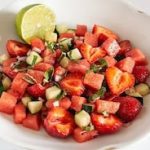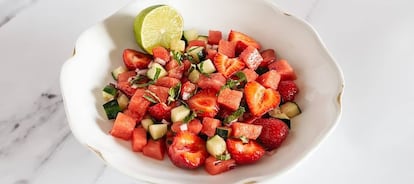


That a ‘food’ carries the label of belonging to the ultra-processed category is one of the worst sentences it can receive, at least as far as its nutritional value and effects on health are concerned. The vast majority of scientific publications warn of the negative association that exists between its consumption and practically any disease you can imagine. The most obvious and repeated are obesity, diabetes, cancer, cardiovascular disease, cavities and, directly, mortality from any cause. We already told it in 2019, and since then the scientific articles that have focused on ultra-processed foods have proliferated like mushrooms, tripling in 2023; always pointing towards its poor link with good health.
But very recently an important work has been published that highlights that not all ultra-processed foods are equally bad, to the point of pointing out that the use of certain categories of ultra-processed foods is related to better indicators of cardiovascular health. I am sure that certain companies – those that put the categories in question on the market – will have received this news with the same joy that Donald Trump receives an exculpatory sentence.
Different ultra-processed foods, different cardiovascular health prognosis
This is not just another study. This is especially important for three reasons: First, because it involves the follow-up of three large North American cohorts, that is, many people – close to 200,000 participants – for a long time (more than 30 years). Second, because this work includes a review and meta-analysis with data from other countries, reaching a total number of more than one million participants. Finally, because the study has been published in one of the most prestigious journals –The Lancet– counting on top researchers (you can access the complete study at this link).

The researchers’ summary of their work could not be more eloquent: in general, the consumption of ultra-processed foods is correlated with a 16% increase in the risk of cardiovascular disease and an 11% increase in suffering from coronary heart disease. These trends are seen among both American adults and adults in other countries.
However, and here is the mother of the lamb; The study reveals that not all categories of ultra-processed foods are associated in the same direction – negatively – with cardiovascular health. Thus, sugary drinks, drinks with artificial sweeteners and processed meats were the food groups most strongly associated with an increased risk of cardiovascular disease. However, the consumption of breads, breakfast cereals, yogurt and dairy desserts and salty snacks – always within the ultra-processed category – obtained an inverse association. That is, these food groups were correlated with a reduced risk of cardiovascular disease.
Another finding, although the researchers were careful to include it in the summary, revealed that the consumption of strong liquors – spirituous drinks – was also associated with a lower risk of coronary heart disease. Let us remember that, within alcoholic beverages, liqueurs fall “by definition” into the NOVA 4 category, that is, they are considered ultra-processed. Not so for fermented alcoholic beverages – typically wine and beer – which would be NOVA 3 or processed products: you can update yourself on the NOVA classification at this link.

Key ideas to avoid going crazy with interpretations
In view of the study, it is possible and even probable that it seems that this type of work only serves to make citizens go crazy, that “today one thing is said and tomorrow another” and “there is no one to clarify with the messages about feeding”. But this perspective is probably only the result of taking the radish by the leaves, staying only with what certain anarcho-consumers may be interested in – the more mess and apparent confusion, the better – and not taking into consideration all the dimensions of the study, from its design to its conclusions. Let’s go with some reflections.
The nature of the study is observational
Formulated as a mantra – a good one – we have to remember that “correlation does not imply causation”; Just because two variables evolve proportionally in one direction or another does not mean that one of the variables is the cause of the other, and vice versa. For example, the more watermelon you eat, the more people drown in the water. But eating watermelon is not the cause of these drownings: it is in summer when more watermelon is eaten and also when there are more deaths due to drowning (because there are more people who bathe).
However, when an association between variables is found, the first thing to investigate is whether there would be a mechanistic explanation that could justify that causality that we do not have in principle. With watermelon and the number of drowned people there is not, but with ultra-processed foods and the increased risk of certain diseases there is. Explanation: the abuse of sugars, certain unhealthy fats, salt, excess calories, etc. – characteristics associated with the nutritional value of ultra-processed foods – does explain the increased risk of the most common non-communicable diseases.

The mechanism of unexpected associations
In reference to the above, the authors of this work also offered a possible explanation when, for the reduction in the risk of cardiovascular disease related to the consumption of ultra-processed breads, breakfast cereals, yogurts and salty snacks. These products, the authors reflect, usually or can have a relatively high profile in fiber, minerals, phenolic compounds, in addition to being fortified in group B vitamins, closely related to the proper functioning of the vascular system. Regarding yogurts, they also noted that -especially natural yogurt-, they are a source of probiotics and certain fatty acids linked to a lower cardiovascular risk. When the authors highlighted the positive association related to the consumption of salty snacks, they used popcorn exclusively as an example.
The type of participants can explain a good part of the results
Although one of the strengths of this study is the significant volume of participants, it must also be said that its characteristics are very specific and are not others. All participants were health professionals, with a medium-high socioeconomic level and the vast majority were white. Knowing this type of data helps explain that the results of this study cannot be extrapolated to the entire population. This work has focused on the observation of dietary habits and prevalence of cardiovascular diseases in, let’s call it, “a certain elite” in North America. This particular is what also helps explain the beneficial association between liquor consumption and reduced risk of coronary heart disease. The WHO explains it very well when it says that: “the beneficial effect on some cardiovascular diseases seems to be due to confounding factors, pointing to the idea that low or moderate alcohol consumption should be considered more as an indicator of good health and a better social position than a cause of the aforementioned good health.”
The authors warn: the less ultra-processed, the better
Don’t forget the first of the conclusions offered by the authors: the consumption of ultra-processed foods is associated with an increased risk of cardiovascular disease and coronary heart disease. Let us also remember that this work does not address the association of ultra-processed foods with diabetes, obesity, hypertension and overall mortality, relationships that have already been highlighted in many other works and seem, for the moment, quite solid. So, with all the law, a diet based on fruits and vegetables, legumes, eggs, whole grains, poultry, fish and seafood, little or no red meat, and drinking water is still recommended for the entire population. the population.
The NOVA classification has its weaknesses
The NOVA classification, used to decide what is ultra-processed in the study, focuses the categorization of foods into four groups based on their degree of processing. For the NOVA 4 category there is a series of relatively diffuse, not precise, criteria that convey a (poor) nutritional assessment of all the products within this group. It is true that a vast majority of products that meet the attributes to be considered NOVA 4 – that is, ultra-processed – have a poor nutritional value, there are also exceptions. That is, there are certain products that, by the very definition of the NOVA 4 category, cannot be included in another group that, however, may be nutritionally interesting. The best example would be a natural yogurt that incorporates, for example, isolated proteins or a sweetener: by definition of the NOVA system itself, the presence of these ingredients automatically places said yogurt in the group of ultra-processed ones, which does not mean that it cannot be Be part of a healthy eating pattern. It is these problems with concreteness that have led certain groups to return to the topic again and again, taking into account the stigma of being classified as ultra-processed. This reality is told to you in a wonderful way by Javier S. Perona in an entry on his blog Malnutridos, author also of an interesting book titled Ultra-processed foods (what do we know about?).
Follow El Comidista on YouTube.